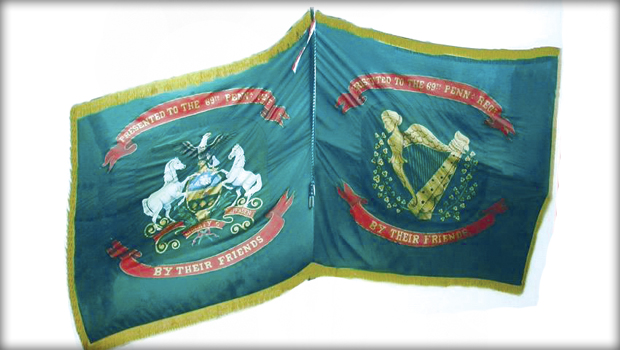Caption: (above) Mirror image of 69th PA flag
A Call to the Irish Community to Honor the Gallant Irish of the Civil War—
You are invited to the 150th Anniversary Ceremony of the 69th PA Infantry Regimental Irish Flag Exchange Ceremony at Independence Hall, 12 Noon, Saturday, March 15, 2014.
By Don Ernsberger
History will be repeated at noon on Saturday March 15, 2014. An event of the American Civil War will be recreated exactly 150 years after it occurred in the midst of that deadly war.
The premier regiment of Philadelphia Irishmen in the Civil War – The 69th Pennsylvania Irish Volunteers – represented by their modern “reenactment” organization will receive in front of Independence Hall a replacement battle flag and retire their worn and tattered flag which they have carried, just as the men they represent did on March 15, 1864.
At noon, before invited guests, a brass band and representatives of Irish organizations, Major John Kopich and Captain Scott Eller will accept the new battle flag and pass it to the 69th Pa color guard.
The old flag will be retired and placed in special preservation just as the old flag was in 1864.
The 28th Pennsylvania Regimental Brass Band, led by musician and Adjutant Jeff Heagy, will play Irish songs.
During the Civil War the term of service for most regiments was three years. As bonus to encourage reenlistment, the US government provided a
bounty payment and a one-month furlough to all veterans who would sign up for service as “Veteran Reserves.”
In addition, any regiment which was able to reenlist more than 50 percent of its soldiers would continue as a designated Volunteer regiment. More than 75 percent of the soldiers of the 69th Pa reenlisted. Those who did not would remain in camp near Brandy Station, Va. until their release in June 1864.
The 71st Pa, 72nd Pa. and the 106th Pa., which made up the remainder of the Philadelphia brigade failed to reenlist 50 percent of their soldiers and were disbanded after the summer of 1864.
The green flag was emblazoned with two red banners with gold lettering on each side proclaiming “Presented to the 69th Pennsylvania” on the top banner and “By their friends” on the bottom. In the middle of one side was a golden harp with a bare-breasted woman as its pillar enclosed with a wreath composed of green leaves and shamrocks. The center of the opposite side was the Commonwealth coat of arms supported by two white horses.
The original green battle flag had been produced in Philadelphia by Irish citizens and delivered to the regiment on the battlefields of Virginia on March 18, 1862 in the small town of Berryville near Harper’s Ferry. That flag had served them well in battles near Richmond; at Antietam; Fredericksburg and later, defending the stone wall and the copse trees at Gettysburg.
After replacement of their flag on March 15, 1864, the regiment marched in the Saint Patrick’s Day parade in Philadelphia and then returned to the war.
The Philadelphia Public Ledger would report on the 69th participation in the Saint Patrick’s Day parade in the March 18th edition:
“St. Patrick’s Day —The gallant 69th Regiment observed St. Patrick’s Day and paraded through a number of the principal streets. A band of music accompanied the regiment and after the parade was dismissed in Independence Square, the musicians performed a number of the American and Irish airs. The 69th Regiment belongs to General Hancock’s Corps and it is expected that its ranks will be filled to the maximum standard before the 30 day furlough expires.” PPL 3/18/1864
The 69th Pennsylvania would play a major role in the upcoming battles of The Wilderness, Spotsylvania, North Anna River and Cold Harbor, taking heavy casualties and losses among many of the men who had served as their leaders in both the pre-war Irish militia and in the war.
By 1865 they were in the trenches at Petersburg, Virginia and helped pursue the Confederate Army to Appomattox. Only 56 of the original 1,006 officers and men who had left Philadelphia in September 1861 would remain by the date Lee surrendered.
During the war neither the original green battle flag nor its 1864 replacement had ever been captured in battle or even touched by an enemy soldier.
The north side of Chestnut Street across from Independence Hall has been saved for audience space for the March 15, 2014 ceremonies. It is expected that large numbers of spectators will be present from Philadelphia
Irish societies. As they did in 1864, the 69th Pa will proudly march with their new colors in the Saint Patrick’s Day Parade on March 16.
Don Ernsberger is chairman of the 69th PA History Committee

